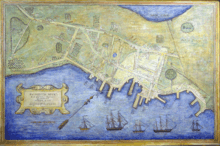HMS Canceaux (1764)
| Career (Great Britain) | |
|---|---|
| Name: | HMS Canceaux |
| General characteristics | |
| Tonnage: | 180 tons |
| Crew: | 40 |
| Armament: | 16 guns[1] |
Canceaux was a 16-gun hydrographic survey sloop of the Royal Navy conducting a coastal survey of North America.[2] The ship left the Saint Lawrence River estuary in 1771[3] to survey the coast of the Maritimes, and became involved with rebellious colonists of New England during the early part of the American Revolutionary War.
December 1774
Paul Revere rode to Portsmouth, New Hampshire on 13 December 1774 to organize a raid on Fort William and Mary on New Castle Island off Portsmouth. Colonists removed sixteen cannon and about one hundred barrels of gunpowder before Canceaux arrived from Boston on December 17 to protect the fort. The local maritime pilot then guided Canceaux into shallow water where it was stranded in the Piscataqua River estuary for several days.[4]
February 1775
Canceaux seized the brigantine Brothers, which was suspected of smuggling.[5]
May 1775
Canceaux anchored in Casco Bay in March 1775 to prevent colonists from enforcing the First Continental Congress boycott of all goods from Britain. Samuel Thompson's militia of Brunswick, Maine attempted to capture the ship commanded by Lieutenant Henry Mowat. After a militia boarding party in small boats had been deterred by grapeshot from Canceaux cannon, the men kidnapped Mowat on May 9 while he was ashore arranging church services for his crew. The first lieutenant aboard Canceaux warned the colonists to release Mowat by discharging two cannon (loaded only with gunpowder, but no shot) toward Portland, Maine. Thompson responded by threatening to cut off one of Mowat's fingers for each cannon shot striking Portland. When word of cannon fire reached surrounding communities, local minutemen converged on Portland and looted the homes of loyalists. Portland residents convinced Thompson to release Mowat, but refused to allow Mowat to take Thompson into custody. The minutemen threatened Mowat and the crew of Canceaux until the ship left for Boston on May 15.[2][6] Canceaux then captured the sloop Elizabeth smuggling provisions from New York to Portsmouth on May 21.[7]
August 1775
Canceaux impressed five crewmen from Elisabeth of Newburyport returning from France.[7]
October 1775

To suppress rebellious activities along the New England coast, Mowat was ordered to undertake a punitive mission to "chastize" the seaports of Marblehead, MA, Salem, MA, Gloucester, MA, Ipswich, MA, Newburyport, MA, Portsmouth, NH, Saco, ME, Portland (Falmouth),ME and particularly Machias, ME.[9] Mowat left Boston aboard Canceaux on 6 October 1775 in company with the 20-gun[1] ship Cat,[8] the 12-gun[1] schooner[8] HMS Halifax,[10] the bomb sloop[8] HMS Spitfire,[10] and the supply ship[8] HMS Symmetry.[10][11][12] Canceaux sailed past the southern seaports to anchor off Portland and avenge insults to her captain's authority. Mowat's flotilla conducted a nine-hour bombardment with incendiary ammunition on October 18 and sent raiding parties ashore to start additional fires.[6] These parties captured four small vessels and destroyed eleven more.
Notes
- ↑ 1.0 1.1 1.2 Goold's gun count includes swivel guns, but not the mortars of the bomb sloop Spitfire. Half (or fewer) of this count were carriage-mounted cannon. Other references indicate Canceaux carried 8 cannon, and Halifax carried 6.
- ↑ 2.0 2.1 Conforti, Joseph Creating Portland: History and Place in Northern New England (2007) pp.31&55-58
- ↑ Robertson, John Ross The history of freemasonry in Canada, from its introduction in 1749 (1900) p.253
- ↑ "Paul Revere's Other Ride". J. Dennis Robinson. Retrieved 2012-01-24.
- ↑ "Ede's and Gill's Boston-gazette". The Library Company of Philadelphia. Retrieved 2012-01-24.
- ↑ 6.0 6.1 "Parallel 44: Why the Royal Navy burned Portland in 1775". The Working Waterfront. Retrieved 2012-01-24.
- ↑ 7.0 7.1 "AMERICAN MARITIME UNITS AND VESSELS AND THEIR SUPPORTERS DURING THE REVOLUTIONARY WAR, 1775-1783)". American War of Independence at Sea. Retrieved 2012-01-24.
- ↑ 8.0 8.1 8.2 8.3 8.4 Goold, William The Burning of Portland 19 February 1873
- ↑ Leamon, James S. Revolution Downeast: The War for American Independence in Maine (1995) University of Massachusetts Press pp.69-70
- ↑ Symmetry may have carried guns, because other references indicate she fired during the Battle of Bunker Hill; but Goold describes her as a magazine for the bomb sloop during this engagement. As a safety measure to prevent loss of a ship through accidental ignition of unfired incendiary carcasses, carcasses were transferred by lighter from a non-firing ship to the bomb sloop as needed.
- ↑ "October, 1775". J. Dennis Robinson. Retrieved 2012-01-24.